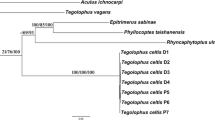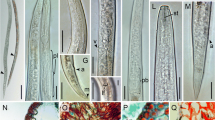Abstract
The eriophyoid mite Aceria massalongoi (Canestrini) was collected from globoid leaf galls on severely injured chaste trees, Vitex agnus-castus L. (Lamiaceae), in Bari and Bernalda (southern Italy), and on the Ionian island Leukade (Greece). Female, male and nymph were described in detail, following the current morphometric descriptive scheme, supplementing older and incomplete descriptions. Molecular characterization of A. massalongoi from Italy and Greece was conducted by amplifying and sequencing the ribosomal ITS, the D2–D3 expansion domains of the 28S rRNA gene and the mitochondrial COI, for the first time. Phylogenetic trees based on the three molecular markers showed congruent results, confirming that Italian and Greek A. massalongoi populations are the same species that cluster together with some intraspecific variability. Galls, ranging from 0.5 to 2.8 mm in diameter, were randomly distributed on both leaf surfaces, and protruded ca. 1 mm from the leaf surface. Sometimes they were closely aggregated on midrib and leaves, which, consequently, appeared strongly deformed. Close-up observations revealed that gall induction causes hyperplastic proliferation of leaf tissues around the gall chamber hosting mites. The uniserial cell lining inside this chamber provides the nutritional tissue for the mites. All feeding cells contained one or more (frequently 2–3) hypertrophied nuclei and dense granular cytoplasm.






Similar content being viewed by others

References
Abolafia J, Liébanas G, Peña-Santiago R (2001) Nematodes of the order Rhabditida from Andalucia Oriental Spain. The subgenus Pseudacrobeles Steiner, 1938, with description of a new species. J Nematode Morphol Syst 4:137–154
Adrover E, Berger MA, Pérez AA, Tarazi FI, Antonelli MC (2007) Effects of prenatal stress on dopamine D2 receptor asymmetry in rat brain. Synapse 61:459–462
Altschul SF, Madden TL, Schaffer AA, Zhang J, Zhang Z, Miller W, Lipman DJ (1997) Gapped BLAST and PSI-BLAST: a new generation of protein database search programs. Nucl Acids Res 25:3389–3402
Amrine JW Jr, Manson DCM (1996) Preparation, mounting and descriptive study of Eriophyoid mites. In: Lindquist EE, Sabelis MW, Bruin J (eds) Eriophyoid mites–their biology, natural enemies and control. World Crop Pests. Elsevier Science Publishing, Amsterdam, vol 6, pp 383–396. https://doi.org/10.1016/S1572-4379(96)80023-6
Amrine JW Jr, Stasny TAH, Flechtmann CHW (2003) Revised keys to world genera of Eriophyoidea (Acari: Prostigmata). Indira Publishing House, West Bloomfield, p 244
Anderson DL, Morgan MJ (2007) Genetic and morphological variation of bee-parasitic Tropilaelaps mites (Acari: Laelapidae): new and re-defined species. Exp App Acarol 43:1–24. https://doi.org/10.1007/s10493-007-9103-0
Avise JC (2000) Phylogeography. The history and formation of species. Harvard University Press, Cambridge
Bickford D, Lohman DJ, Sodhi NS, Ng PKL, Winker K, Ingram KK, Das I (2007) Cryptic species as a window on diversity and conservation. Trends Ecol Evol 22:148–155. https://doi.org/10.1016/j.tree.2006.11.004
Canestrini G (1890) Ricerche intorno ai Fitoptidi. Atti Soc Veneto-Trentina Sci Nat Padova 12(1):1–26, plates 6–7
Canestrini G (1891) Ricerche intorno ai fitoptidi. Atti Soc Veneto-Trentina Sci Nat Padova 12(1):40–63
Canestrini G (1892) Prospetto dell’Acarofauna Italiana. Parte V. Famiglia dei Phytoptini (Phytoptidae). Atti Soc Veneto-Trentina Sci Nat Padova ser II 1:543–557 ((589–722, plates 44–59))
Castillo P, Vovlas N, Subbotin S, Troccoli A (2003) A new root-knot nematode, Meloidogyne baetica n. sp. (Nematoda: Heteroderidae), parasitizing wild olive in Southern Spain. Phytopathology 93:1093–1102. https://doi.org/10.1094/phyto.2003.93.9.1093
Cvrkovic T, Chetverikov P, Vidovic B, Petanovic R (2016) Cryptic speciation within Phytoptus avellanae s.l. (Eriophyoidea: Phytoptidae) revealed by molecular data and observations on molting Tegonotus-like nymphs. Exp Appl Acarol 68:83–96. https://doi.org/10.1007/s10493-015-9981-5
Dçbski B (1918) Cécidies signalées en Ègypte jusqu’a ce jour. Mém Soc Entomol Ègypte 1(4):1–37
de Lillo E, Skoracka A (2010) What’s “cool” on eriophyoid mites? Exp Appl Acarol 51(1–3):3–30. https://doi.org/10.1007/s10493-009-9297-4
de Lillo E, Craemer C, Amrine JW Jr, Nuzzaci G (2010) Recommended procedures and techniques for morphological studies of Eriophyoidea (Acari: Prostigmata). Exp Appl Acarol 51(1–3):283–307. https://doi.org/10.1007/s10493-009-9311-x
de Lillo E, Pozzebon AL, Valenzano D, Duso C (2018) An intimate relationship between eriophyoid mites and their host plants—a review. Front Pl Sci 9(1786):1–14. https://doi.org/10.3389/fpls.2018.01786
De Luca F, Fanelli E, Di Vito M, Reyes A, De Giorgi C (2004) Comparison of the sequences of the D3 expansion of the 26S ribosomal genes reveals different degrees of heterogeneity in different populations and species of Pratylenchus from the Mediterranean region. Eur J Plant Pathol 111:949–957. https://doi.org/10.1007/s10658-004-0813-4
Denizhan E, Monfreda R, de Lillo E, Çobanoğlu S (2015) Eriophyoid mite fauna (Acari: Trombidiformes: Eriophyoidea) of Turkey: new species, new distribution reports and an updated catalogue. Zootaxa 3991:1–63. https://doi.org/10.11646/zootaxa.3991.1.1
Doğan Y, Süleyman B, Hasan HM, Güngӧr A (2003) Plants used as natural dye sources in Turkey. Econ Bot 57(4):442–453
Farkas HK (1965) Familie Eriophyidae, Gallmilben. Die Tierwelt Mitteleuropas 3(3):1–155
Hebert PDN, Ratnasingham S, de Ward JR (2003) Barcoding animal life: cytochrome c oxidase subunit I divergence among closely related species. Proc R Soc B 270:S96–S99. https://doi.org/10.1098/rsbl.2003.0025
Hirobe C, Qiao ZS, Takeya K, Itokawa H (1997) Cytotoxic flavonoids from Vitex agnus-castus. Phytochem 46(3):521–524
Jočić I, Petanović R (2012) Checklist of the eriophyoid mite fauna of Montenegro (Acari: Prostigmata: Eriophyoidea). Acta Entomol Serb 17(1/2):141–166
Johansen DA (1940) Plant microtechnique. McGraw Hill, New York, p 523
Jones WHS (1966) Pliny natural history with an english translation in ten volumes. Cambridge
Joyce SA, Reid A, Driver F, Curran J (1994) Application of polymerase chain reaction (PCR) methods to the identification of entomopathogenic nematodes. In: Burnell AM, Ehlers RU, Masson JP (Eds). Cost 812 Biotechnology: genetics of entomopathogenic nematodes-bacterium complexes. In: Proceedings of symposium and workshop, St Patrick’s College, Maynooth, County Kildare, Ireland. Luxembourg, European Commission, DGXII, pp 178–187
Kanzaki N, Futai K (2002) A PCR primer set for determination of phylogenetic relationships of Bursaphelenchus species within xylophilus group. Nematology 4:35–41
Khaing TM, Shim JK, Lee KY (2014) Molecular identification and phylogenetic analysis of economically important acaroid mites (Acari: Astigmata: Acaroidea) in Korea. Entomol Res 44:331–337. https://doi.org/10.1111/1748-5967.12085
Keifer HH (1975) Eriophyoidea Nalepa. In: Jeppson LR, Keifer HH, Baker EW (eds) Mites injurious to economic plants. University of California Press, Berkeley, pp 327–533
Kumar S, Stecher G, Li M, Knyaz C, Tamura K (2018) MEGA X: molecular evolutionary genetics analysis across computing platforms. Mol Biol Evol 35:1547–1549
Lewandowski M, Skoracka A, Szydło W, Kozak M, Druciarek T, Griffiths D (2014) Genetic and morphological diversity of Trisetacus species (Eriophyoidea: Phytoptidae) associated with coniferous trees in Poland: phylogeny, barcoding, host and habitat specialization. Exp Appl Acarol 63:497–520. https://doi.org/10.1007/s10493-014-9805-z
Li HS, Hoffmann AA, Guo JF, Zuo Y, Xue XF, Pang H, Hong XY (2016) Identification of two lineages of host eriophyoid mites predisposed to different levels of host diversification. Mol Phylogen Evol 105:235–240
Lindquist EE (1996) External anatomy and notation of structures. In: Lindquist EE, Sabelis MW, Bruin J (eds) Eriophyoid mites—their biology, natural enemies and control. World Crop Pests, vol 6. Elsevier Science Publishing, Amsterdam, pp 3–31. https://doi.org/10.1016/S1572-4379(96)80003-0
Liu Q, Yun Y-M, Lai Y, Wang G-Q, Xue X-F (2019) Unravelling the phylogeny, cryptic diversity and morphological evolution of Diptilomiopus mites (Acari: Eriophyoidea). Exp Appl Acarol 79:323–344
Mehlhorn H, Schmahl G, Schmidt J (2005) Extract of the seeds of the plant Vitex agnus-castus proven to be highly efficacious as a repellent against ticks, fleas, mosquitoes and biting flies. Parasitol Res 95(5):363–365. https://doi.org/10.1007/s00436-004-1297-z
NalepaA (1925) Beiträge zur Kenntnis der Weiden–Gallmilben. Marcellia 21(1–6):31–58
Navajas M, Navia D (2010) DNA-based methods for eriophyoid mite studies: review, critical aspects, prospects and challenges. Exp Appl Acarol 51(1–3):257–271. https://doi.org/10.1007/s10493-009-9301-z
Palomares-Rius JE, Escobar C, Cabrera J, Vovlas A, Castillo P (2017) Anatomical alterations in plant tissues induced by plant-parasitic nematodes. Front Plant Sci 8:1987. https://doi.org/10.3389/fpls.2017.01987
Petanović RU (2016) Towards an integrative approach to taxonomy of Eriophyoidea (Acari, Prostigmata)—an overview. Ecol Mont 7:580–599
Petanović RU, Kielkiewicz M (2010) Plant-eriophyoid mite interactions: specific and unspecific morphological alterations. Part II. Exp Appl Acarol 51:81–91. https://doi.org/10.1007/978-90-481-9562-6_5
Ramezani M, Amin G, Jalili E (2010) Antinociceptive and anti-inflammatory effects of hydroalcoholic extract of Vitex agnus-castus fruit in mice. J Shahrekord Univ Med Sci 11:46–51
Roivainen H (1953) Some gall mites (Eriophyidae) from Spain. Arch Inst Aclimat 1:9–43
Sabelis MW, Bruin J (1996) Evolutionary ecology: life history patterns, food plant choice and dispersal. In: Lindquist EE, Sabelis MW, Bruin J (eds) Eriophyoid mites—their biology, natural enemies and control. World Crop Pests, vol 6. Elsevier Science Publishing, Amsterdam, pp 329–366
Schopmeyer CS (1974) Seeds of woody plants in the United States. U.S. Dep. Agric., Forest Service Agricultural Handbook 450, Washington, DC, 883 pp
Schulz V, Hansel R, Tyler VE (1998) Rational phytotherapy: a physicians’ guide to herbal medicine. Springer, New York
Skoracka A, Dabert M (2010) The cereal rust mite Abacarus hystrix (Acari: Eriophyoidea) is a complex of species: evidence from mitochondrial and nuclear DNA sequences. Bull Entomol Res 100:263–272. https://doi.org/10.1017/S0007485309990216
Skoracka A, Smith L, Oldfield G, Cristofaro M, Amrine JWJr (2010) Host-plant specificity and specialization in eriophyoid mites and their importance for the use of eriophyoid mites as biocontrol agents of weeds. Exp Appl Acarol 51(1–3):93–113. https://doi.org/10.1007/s10493-009-9323-6
Skoracka A, Kuczyński L (2012) Measuring the host specificity of plant-feeding mites based on field data-a case study of the Aceria species. Biologia 67:546–560
Skoracka A, Kuczyński L, Rector B, Amrine JW Jr (2014) Wheat curl mite and dry bulb mite: untangling a taxonomic conundrum through a multidisciplinary approach. Biol J Linn Soc 111:421–436. https://doi.org/10.1111/bij.1221
Skoracka A, Magalhães S, Rector BG, Kuczyński L (2015) Cryptic speciation in the Acari: a function of species lifestyles or our ability to separate species? Exp Appl Acarol 67:165–182. https://doi.org/10.1007/s10493-015-9954-8
Tajaddod S, Lotfollahi P, de Lillo E (2018) Two new Aceria species (Acari: Trombidiformes: Eriophyoidea) from Ajabshir, Iran. Syst Appl Acarol 23(2):305–313. https://doi.org/10.11158/saa.23.2.7
The Plant List (2013) Version 1.1. https://doi.org/http://www.theplantlist.org (accessed 1 Jan 2020)
Tomasi E (2014) Indagine cecidologica sulla pianura e le lagune friulane (Italia NE). Atti Mus Civ St Nat Trieste 56:43–202
Uzun M, Kaya A (2016) Ethnobotanical research of medicinal plants in Mihalgazi (Eskişehir, Turkey). Pharm Biol 54(12):2922–2932. https://doi.org/10.1080/13880209.2016.1194863
Vidović B, Kamali H, Petanović R, Cristofaro M, Weyl P, Ghorbanali A, Cvrković T, Augé M, Marini F (2018) A new Aceria species (Acari: Trombidiformes: Eriophyoidea) from West Asia, a potential biological control agent for the invasive weed camelthorn, Alhangi maurorum Medik (Leguminosae). Acarologia 58:302–312. https://doi.org/10.24349/acarologia/20184243
Xue XF, Dong Y, Deng W, Hong XY, Shao R (2017) The phylogenetic position of eriophyoid mites (superfamily Eriophyoidea) in Acariformes inferred from the sequences of mitochondrial genomes and nuclear small subunit (18) rRNA gene. Mol Phylogen Evol 109:271–282
Acknowledgements
The authors are thankful to Nicola Vovlas IPSP CNR, Bari UOS (Italy) for suggestions and useful comments on the manuscript, to Nicola Trisciuzzi and Simona Santoro of CRSFA (Locorotondo, Italy) and Hortoservice (Noicattaro, Italy), respectively, for their help and assistance during the mite collections. The authors thank a lot the reviewers for all suggestions improving the manuscript. This study was partly supported by the University ‘Aldo Moro’ of Bari.
Author information
Authors and Affiliations
Corresponding authors
Ethics declarations
Conflict of interest
The authors declare that they have no conflict of interest.
Additional information
Publisher's Note
Springer Nature remains neutral with regard to jurisdictional claims in published maps and institutional affiliations.
Electronic supplementary material
Below is the link to the electronic supplementary material.
10493_2020_518_MOESM2_ESM.png
Phylogenetic trees of mitochondrial COI of Acerie massalongoi and the closest species. Sequences were analysed using Maximum Likelihood method. Number at nodes indicate bootstrap values. Supplementary file2 (PNG 710 kb)
10493_2020_518_MOESM3_ESM.png
Phylogenetic trees of the D2 expansion domain of the 28S rRNA gene of Aceria massalongoi and the closest species. Sequences were analysed using Maximum Likelihood method. Number at nodes indicate bootstrap values. Supplementary file3 (PNG 1347 kb)
Rights and permissions
About this article
Cite this article
de Lillo, E., Fanelli, E., Valenzano, D. et al. Characterisation of Aceria massalongoi and a histopathological study of the leaf galls induced on chaste trees. Exp Appl Acarol 82, 33–57 (2020). https://doi.org/10.1007/s10493-020-00518-x
Received:
Accepted:
Published:
Issue Date:
DOI: https://doi.org/10.1007/s10493-020-00518-x



